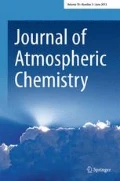Abstract
Daily ozone soundings over Switzerland in the winter of 1979 showed, at the end of January some extremely high values of the ozone mixing ration around the 10 mb level-9 to 10 ppm compared with a climatological mean of 6 ppm. At the same time, the temperature and ozone mixing ratio was measured by the LIMS experiment (Limb Infrared Monitor of the Stratosphere) on Nimbus 7. The single LIMS ozone profiles, as well as the LIMS 10 mb ozone maps, also showed extreme ozone maxima. Ozone transport was investigated by trajectory computations based on the LIMS geopotential height fields. Displacements and deformations of air parcel chains in 48 h were used to construct ozone maps, using the distribution on a previous day. The correspondence of such kinematically-constructed ozone maps using the actual LIMS maps is striking. This method is, thus, a strong indication of the self-consistency of the different LIMS products (ozone, temperature, geopotential) and explains the unusual ozone observations.
Similar content being viewed by others
References
Danielsen, E. F., 1974, Review of trajectory methods, Adv. Geoph. 18B, 73–94.
Dütsch, H. U., 1978, Vertical ozone distribution on a global scale, Pure Appl. Geophys. 116, 511–529.
Dütsch, H. U., and Braun, W., 1980, Daily ozone soundings during two winter months including a sudden stratospheric warming, Geophys. Res. Lett. 7, 785–788.
Gille, J. C. and Russell, J. M., 1984, The Limb Infrared Monitor of the Stratosphere (LIMS): Experiment description, performance and results. To appear in J. Geophys. Res.
Hsu, Ch.-P. F., 1980, Air parcel motions during a numerically simulated sudden stratospheric warming, J. Atmos. Sci. 37, 2768–2792.
Kohri, W. J., 1981, LRIR observations of the structure and propagation of the stationary planetary waves in the northern hemisphere during December 1975, Cooperative Thesis No. 63, Drexel University and National Center for Atmospheric Research.
Labitzke, K., 1979, The major stratospheric warming during January–February 1979, Beilage zur Berliner Wetterkarte, 8 May 1979.
Mahlman, J. D. et al., 1980, Three-dimensional tracer structure and behavior as simulated in two ozone precursor experiments, J. Atmos. Sci. 37, 665–685.
McIntyre, M. E., 1980, An introduction to the generalised Lagrangian-mean description of wave, mean-flow interaction, Pure Appl. Geophys. 118, 152–176.
McIntyre, M. E. and Palmer, T. W., 1983, Breaking planetary waves in the stratosphere, Nature 305, 593–600.
Author information
Authors and Affiliations
Rights and permissions
About this article
Cite this article
Braun, W., Dütsch, H.U. The origin of ozone-rich air in the middle stratosphere observed over Europe at the end of January 1979. J Atmos Chem 2, 163–173 (1984). https://doi.org/10.1007/BF00114129
Received:
Revised:
Issue Date:
DOI: https://doi.org/10.1007/BF00114129




